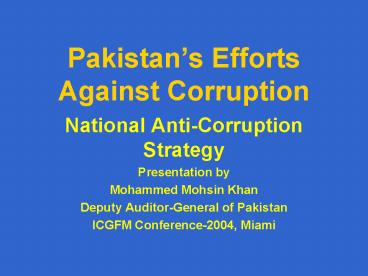Pakistans Efforts Against Corruption - PowerPoint PPT Presentation
1 / 41
Title:
Pakistans Efforts Against Corruption
Description:
Misuse of entrusted power for private benefit. Why so much focus on anti-corruption framework? ... Remuneration within the ambit of a general civil services reform ... – PowerPoint PPT presentation
Number of Views:1958
Avg rating:5.0/5.0
Title: Pakistans Efforts Against Corruption
1
Pakistans Efforts Against Corruption
- National Anti-Corruption Strategy
- Presentation by
- Mohammed Mohsin Khan
- Deputy Auditor-General of Pakistan
- ICGFM Conference-2004, Miami
2
Defining Corruption
- Misuse of entrusted power for private benefit
3
Why so much focus on anti-corruption framework?
4
TI-Survey on Causes of Corruption-Mega Petty
- Lack of Accountability (31.68)
- Low salaries (16.54)
- Monopoly of power (16.43)
- Discretionary powers (12.61)
- Lack of transparency (9.97)
- Power of influential people (4.59)
- Red Tapism (4.28)
- Others 4.9)
- Source NACS-NAB, Government of Pakistan
5
Institutional Framework for AC
- Federal Investigation Agency
- Provincial Anti-corruption Establishments
- National Accountability Bureau
- Accountability Courts
6
Anti-corruption regulatory framework
- Pakistan Penal Code-1860
- Prevention of Corruption Act-1947
- Government Servants Conduct Rules
- The NAB Ordinance- 1999
7
Vision-NAB
- Eradication of Corruption from Pakistan
8
- The Approach
9
(No Transcript)
10
Why top down?
- No immunity and no one above law
11
- The Record
12
OVERVIEW OF PROSECUTION PROGRESSCATEGORY WISE
(SourceNAB)
13
- The Impact
14
- Reduction of corruption from the highest levels
- Establishment of credibility
- Sustainability assured
- General respect and fear of accountability
15
National Anti-corruption Strategy
- 18th November 2003
16
First attempt to develop an anti-corruption
preventive model
Through
17
- The National Anti-corruption Strategy
By adopting a three pronged approach Of -
Prevention - Awareness - Enforcement
18
(No Transcript)
19
- The Project
20
Consultations Study of successful models Study
of international best practices
Research
Feb. 2002 to Sept 2002
Recommendations for all sectors
National Integrity System
Implementation Action Plan
Time bound Specific responsibility
21
Sustainable Development
Rule of Law
Quality of Life
22
Implementation mechanism of National
Anti-corruption Strategy
23
Stakeholders are responsible for implementation
of recommendations in their respective areas
24
Implementation Committee
25
Vision
- A stable Pakistan that is prosperous and has
self sustaining integrity mechanisms by which
corruption is eliminated
26
Objectives
27
Immediate
- Build political will and ownership of NACS by
key stakeholders within key integrity pillars
28
Short Term
- Widen ownership of NACS within key national
integrity pillars, both horizontally and
vertically
29
Medium Term
- Enable key institutions within the national
integrity pillars to implement NACS on their own
initiative
30
Long Term
- Enable self-sustaining ownership of
anti-corruption measures, removing need for
specific NACS
31
General Contours of Implementation
32
Contours of Implementation
- Awareness/Education
- Support to other governance initiatives
- Strengthening Enforcement
- Assisting stakeholders in initiating preventive
efforts - Pilot projects
- Monitoring of NACS impact
33
Some decisions and steps
- Project for Improving Financial Reporting
Auditing-transparency accountability - Strengthening Internal Controls CFO IA
- Establishment of Vigilance Units
- Computerization of Asset declarations and their
monitoring - Access to information proposed changes in Rules
of Business 1973
34
Some other Areas in the pipeline
- Repeal of Benami practices
- Remuneration within the ambit of a general
civil services reform - Transparent procurement systems
35
The Awareness campaign
36
Objectives of Awareness Campaign
- Mobilize public support in the fight against
corruption through - Creating awareness of ill effects of corruption
including impact on poverty alleviation and other
development programs - Educating the people in how to be effective
partners against corruption - Promote positive values to change the ethos and
create abhorrence of corruption
37
Target Groups
- Initial target audience are the urban middle
class because - They have the maximum potential as change agents
- Easier to access
- More individualistic than rural populace
38
Target Groups
- Later the campaign would concentrate on the rural
areas. - The tools and methodology would be different
39
Other Target Groups
- Students are a constant target group
- Civil Servants
- legislators
40
Tools to be used
- Mass media
- Direct Interaction
- Changes in curriculum
- Co-curricular activities for students
- Workshops with ministries/training academies
- Miscellaneous
41
- Thank You

